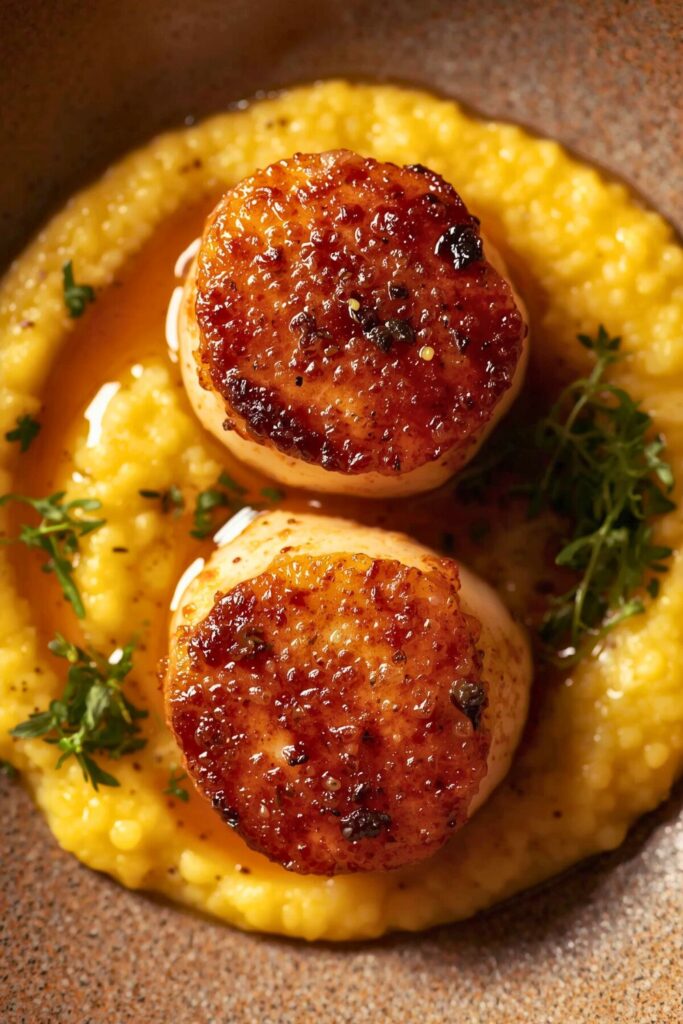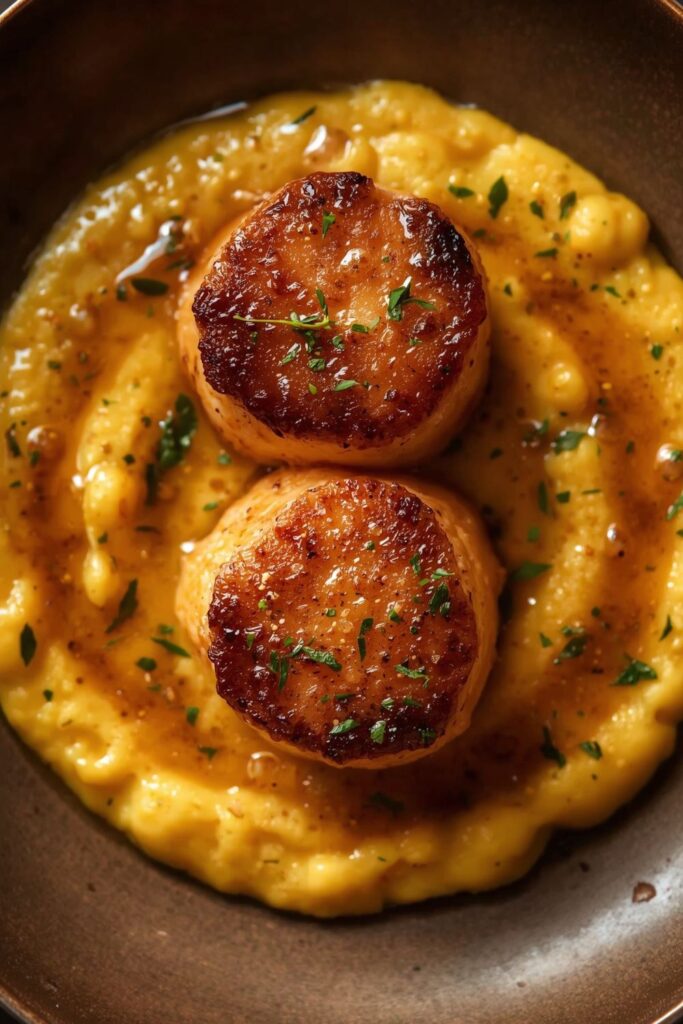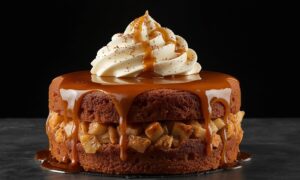Picture this: you’re standing in front of the seafood counter, staring at those gorgeous sea scallops, when suddenly you realize you’ve been treating them like chicken breasts your whole life. Boring sautés, predictable preparations, zero personality. But what if I told you there’s a way to transform these ocean gems into Honey Butter Blackened Scallops with Herby Polenta, something so unforgettable it’ll make your dinner guests forget their own names?
That’s exactly what happened to me three years ago at a tiny coastal restaurant in Maine. The chef sent out these impossibly caramelized scallops nestled on a cloud of creamy polenta, and I swear the entire dining room went silent for thirty seconds. Not because the food was bad, because it was so ridiculously good that everyone forgot how to speak.
This Honey Butter Blackened Scallops With Herby Polenta recipe isn’t just dinner. It’s your secret weapon for turning any ordinary Tuesday into something worth remembering. The blackened crust gives you that satisfying char while keeping the inside silk smooth, and the honey butter? That’s where the magic really happens. Meanwhile, the herby polenta acts like the world’s most sophisticated comfort food, creamy, aromatic, and completely irresistible.
Here’s what makes this dish absolutely genius: you’re gonna get restaurant quality results with techniques so simple they’ll become second nature. The blackening seasoning creates this incredible flavor depth without any of that harsh spice burn. And that herby polenta? It’s basically fancy grits that went to culinary school.
Getting the Perfect Ingredients

What You’ll Need for the Scallops
- 1½ pounds large sea scallops (U-10 or U-12 size)
- 3 tablespoons blackening seasoning (homemade or quality store bought)
- 4 tablespoons unsalted butter
- 2 tablespoons honey
- 1 tablespoon fresh lemon juice
- 2 tablespoons neutral oil (like grapeseed or canola)
For the Herby Polenta
- 1 cup coarse ground polenta (not instant, trust me on this)
- 4 cups chicken or vegetable stock
- 1 cup whole milk
- ½ cup freshly grated Parmesan cheese
- 3 tablespoons butter
- 2 tablespoons fresh chives, finely chopped
- 1 tablespoon fresh thyme leaves
- 1 teaspoon fresh rosemary, minced fine
- Salt and black pepper to taste
Now, let’s talk scallop selection because this is where most people mess up. You want “dry” scallops, the kind that haven’t been treated with sodium tripolyphosphate. Wet scallops will never get that gorgeous golden crust we’re after. They’ll just steam and turn gray, which is nobody’s idea of appetizing.
Look for scallops that smell like ocean breeze, not fishy at all. They should feel firm and slightly sticky to the touch. If they’re sliding around like they’re covered in slime, keep walking. Size matters here too, those tiny bay scallops won’t work for this technique. You need the big sea scallops that can handle serious heat.
Smart Ingredient Swaps That Actually Work
Can’t find good sea scallops? Thick cut halibut or monk fish medallions work beautifully with this same technique. Just adjust your cooking time slightly.
No coarse polenta around? Regular cornmeal works in a pinch, but you’ll need to whisk constantly and cook it a bit longer. Instant polenta is gonna give you baby food texture, so avoid it unless you’re desperate.
For the herbs, dried just won’t cut it here. Fresh herbs are what make this polenta sing. But if you absolutely must substitute, use about one third the amount of dried herbs and add them earlier in the cooking process.
Lactose intolerant friends can swap the milk for unsweetened oat milk or cashew cream. The Parmesan is harder to replace, but nutritional yeast with a pinch of salt gets you surprisingly close to that umami depth.
Mastering the Honey Butter Blackened Technique

Getting Your Polenta Started First
Start with the polenta because it needs time to develop that creamy texture. Here’s the thing most people don’t know, you want to bring your stock and milk to a gentle simmer before you even think about adding the polenta. Cold liquid plus polenta equals lumpy disaster.
Slowly whisk in that polenta like you’re conducting an orchestra. Steady stream, constant whisking, no rushing. The minute you get impatient and dump it all in at once, you’re gonna have polenta concrete that no amount of whisking can fix.
Once it’s incorporated, drop the heat to the lowest setting your stove’s got. This stuff needs to bubble lazily for about 45 minutes, and you’re gonna stir it every ten minutes or so. I like to use a wooden spoon and really get into the corners of the pot.
The polenta’s ready when it pulls away from the sides of the pot slightly and coats your spoon thick enough that you can draw a line through it with your finger. That’s when you fold in your butter, cheese, and herbs. Taste it, this should be so good you could eat it straight with a spoon.
The Scallop Searing Science
While that polenta’s doing its thing, let’s prep those scallops. First rule of scallop club, remove that side muscle. It’s tough and chewy and has no business being on your plate. Just pinch it off with your fingers.
Pat those scallops completely dry with paper towels. I mean bone dry. Any moisture left on the surface is gonna prevent that blackened crust from forming. Some chefs even let their scallops sit on paper towels in the fridge for an hour before cooking.
Season them right before they hit the pan. Blackening seasoning draws out moisture, so don’t do this step too early. Just before cooking, coat each scallop evenly with the seasoning. You want good coverage but not so much that you can’t see the scallop underneath.
Here’s where people usually panic, you need your pan screaming hot. I’m talking about smoking slightly. A heavy bottomed stainless steel or cast iron pan works best. Non stick won’t get hot enough for proper blackening.
Add your oil and immediately place those scallops in the pan. Don’t crowd them, they need space to sear properly. You should hear that satisfying sizzle the moment they hit the surface.
The Critical Don’t Touch Phase
This is the hardest part for most home cooks, leave them alone. No peeking, no poking, no moving them around. Let them sear undisturbed for about 3-4 minutes depending on their size. You’ll know they’re ready to flip when they release easily from the pan.
Flip them once, just once. Add your butter to the pan now and let it foam up around the scallops. This is where that honey butter magic happens. Drizzle the honey right into that foaming butter and watch it caramelize slightly.
Baste those scallops with the honey butter using a spoon. Tilt the pan slightly and just keep spooning that golden goodness over the tops. Another 2-3 minutes and they should be perfectly caramelized and just cooked through.
The internal temperature should hit about 120°F for that perfect slightly translucent center. Overcook these babies and you’ll have expensive rubber bands.
The Science Behind Perfect Blackening
Real blackening isn’t about burning your food, it’s about creating a deeply flavorful crust through the magic of the Maillard reaction. When proteins and sugars hit high heat, they transform into hundreds of new flavor compounds that taste like concentrated deliciousness.
The key is getting that surface hot enough for the reaction to happen quickly, before the interior overcooks. That’s why we need such high heat and why moisture is the enemy. Every drop of water on the surface has to evaporate before browning can begin.
The honey in our butter mixture isn’t just for sweetness, it’s adding more sugars to participate in that Maillard browning. Plus, honey caramelizes at a lower temperature than regular sugar, giving you deeper flavor development without burning.
Polenta works on completely different science. Those corn starches are slowly hydrating and swelling, creating that creamy texture. The constant stirring prevents the starches from clumping together, while the long cooking time allows them to fully soften.
The cheese and butter aren’t just for richness, they’re adding fat molecules that coat your tongue and carry flavor compounds more effectively. That’s why restaurant polenta always tastes more intense than the stuff you make at home.
Plating Like a Pro
The Foundation Matters
Start with warm plates, this isn’t optional. Cold plates will cool down your food immediately and make that beautiful butter sauce congeal. Just pop them in a 200°F oven for a few minutes while you’re finishing the scallops.
Spoon your polenta into the center of each plate, but don’t just plop it down. Use the back of your spoon to create a smooth, even circle. Think of it as your canvas.
Nestle those gorgeous blackened scallops right on top of the polenta. The contrast between the dark crust and creamy polenta is gonna be stunning. Three scallops per plate usually works perfectly for an elegant presentation.
The Final Flourishes
Drizzle any remaining honey butter from the pan around the plate, not on top of the scallops where it might make them soggy, but around the edges where it creates beautiful golden pools.
A light sprinkle of fresh herbs over everything ties it together visually. I like to save some chives and thyme leaves specifically for this moment.
A tiny squeeze of fresh lemon juice over the scallops right before serving brightens everything up and cuts through that rich honey butter beautifully.
Perfect Pairings That Make Sense
This dish plays beautifully with a crisp white wine, think Sancerre or a good Muscadet. The acidity cuts through the richness while complementing the seafood perfectly. If you’re more of a red wine person, a light Pinot Noir from Oregon works surprisingly well.
For sides, keep it simple. A bright arugula salad with lemon vinaigrette provides the perfect acidic counterpoint. Or try some simply grilled asparagus with just olive oil and salt.
The beauty of this Honey Butter Blackened Scallops With Herby Polenta combination is that it’s rich enough to be the star of the show. You don’t need a dozen sides competing for attention.
Making It Your Own

Once you’ve mastered the basic technique, this recipe becomes your playground. Try different herb combinations in the polenta, sage and brown butter is incredible in the fall. Or go Mediterranean with oregano and sun dried tomatoes.
The blackening seasoning can be customized too. Add more cayenne if you like heat, or throw in some smoked paprika for deeper flavor. Some cooks add a tiny bit of brown sugar to their blend for extra caramelization.
You can even make this dish ahead for entertaining. The polenta holds beautifully in a slow cooker on warm, and the scallops only take minutes to sear when your guests arrive.
This recipe taught me something important about cooking, sometimes the most impressive dishes come from treating simple ingredients with respect and understanding how they work. Those scallops don’t need to be buried under complicated sauces. They just need the right heat, the right timing, and that touch of honey butter magic.
The next time you’re staring at those beautiful scallops at the seafood counter, you’ll know exactly what to do with them. And trust me, once you make this dish, you’ll never go back to boring sautéed scallops again.
Frequently Asked Questions
Why won’t my scallops get a good sear?
The most common culprit is moisture. Those “wet” scallops treated with sodium tripolyphosphate will never sear properly because they’re holding too much water. Always look for “dry” scallops, pat them completely dry before seasoning, and make sure your pan is smoking hot before they go in. Also, don’t overcrowd the pan, the scallops will steam instead of sear.
Can I make the polenta ahead of time?
Absolutely! Polenta actually improves when it sits for a while. Make it up to two days ahead and store it covered in the fridge. When you’re ready to serve, reheat it gently with a splash of warm stock or milk, stirring constantly. The texture might thicken up, so don’t be afraid to thin it out gradually until it’s creamy again.
What if my honey butter mixture separates?
Don’t panic, this happens sometimes when the pan gets too hot or if you add the honey too quickly. Take the pan off the heat immediately and whisk in a tablespoon of cold butter. The cold fat will help emulsify everything back together. If it’s still separated, add a splash of cream and whisk vigorously off the heat.
How do I know when the scallops are perfectly cooked?
Perfect scallops should be golden brown on both sides with a slightly translucent center, think medium rare steak but for seafood. They should feel firm but still give slightly when pressed. If you’ve got a thermometer, you’re looking for about 120°F internal temperature. Overcooked scallops become rubbery and lose that tender, sweet texture that makes them special.
Can I use instant polenta to save time?
While you can use instant polenta in a pinch, you’re gonna sacrifice a lot of texture and flavor. Instant polenta cooks so quickly that it doesn’t have time to develop that rich, creamy consistency that makes this dish special. If time is really an issue, try the quick cooking polenta varieties, they’re a good middle ground between convenience and quality.

Swiftly Captions by Tina Smith — Quick, flavorful food recipes made simple, bringing fresh inspiration to your kitchen every day






